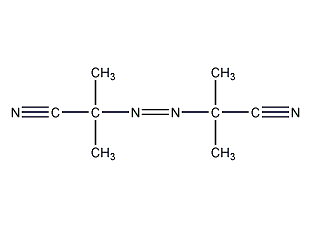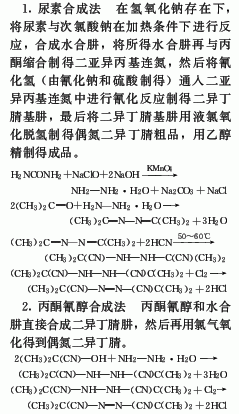
Structural formula
| Business number | 01NB |
|---|---|
| Molecular formula | C8H12N4 |
| Molecular weight | 164 |
| label |
2,2′-Azobisisobutyronitrile, Pore-forming agent N, Azobisisobutyronitrile, 2,2′-Azobis(2-methylpropionitrile), 2,2-Azobisisobutyronitrile, Nitrile, 2,2′-Azobis(2-methylpropionitrile) |
Numbering system
CAS number:78-67-1
MDL number:MFCD00013808
EINECS number:201-132-3
RTECS number:UG0800000
BRN number:1708400
PubChem number:24847282
Physical property data
1. Character: white transparent crystal[1]
2. Melting point (decomposition, ℃): 110[2]
3. Octanol/water partition coefficient: 1.1[3]
4. Ignition temperature (℃): 64[4]
5. Solubility: Insoluble in water, soluble in ethanol, ether, toluene, methanol and other organic solvents and vinyl monomers. [5]
Toxicological data
1. Acute toxicity
Rat caliber LD50: 100mg/kg; rat inhalation LC50: >12 gm/m3/4H; rat abdominal LD50: 25mg/kg; rat subcutaneous LD50: 30mg/kg; mouse caliber LD50: 700mg/kg; mouse subcutaneous LD50: 40mg/kg; rabbit subcutaneous LD50: 50mg/kg; pig subcutaneous LD50: 50mg/kg.
2. Other multi-dose toxicity data Rat caliber TDLO: 2200mg/kg/11D-C
3. Acute toxicity[6] LD50: 100mg/kg (orally in rats); 700mg/kg (orally in mice)
4. Irritation No information available
5. Subacute and chronic toxicity[7] Rat oral administration 32 mg/m3, fatal in 30 days, repeated inhalation of volatile substances heated to 70~80℃ for 2 hours a day, 8~10 days, causing excitement, difficulty breathing, and sometimes convulsions. The anatomy showed changes such as bleeding and edema in the lungs; pathological changes in the liver and kidneys.
Ecological data
1. Ecotoxicity No data available
2. Biodegradability No data available
3 .Non-biodegradability No information available
Molecular structure data
1. Molar refractive index: 49.67
2. Molar volume (cm3/mol): 171.5
3. Isotonic specific volume (90.2K ): 416.7
4. Surface tension (dyne/cm): 34.8
5. Polarizability (10-24cm3): 19.69
Compute chemical data
1. Reference value for hydrophobic parameter calculation (XlogP): 1.3
2. Number of hydrogen bond donors: 0
3. Number of hydrogen bond acceptors: 4
4. Number of rotatable chemical bonds: 2
5. Number of tautomers: none
6. Topological molecule polar surface area 72.3
7.Number of heavy atoms: 12
8. Surface charge: 0
9. Complexity: 251
10. Number of isotope atoms: 0
11. Determine the atomic position Number of stereocenters: 0
12. Uncertain number of stereocenters of atoms: 0
13. Determined number of stereocenters of chemical bonds: 0
14. No Determine the number of stereocenters of chemical bonds: 0
15. The number of covalent bond units: 1
Properties and stability
1. Keep away from fire and heat sources. The decomposition temperature is 98~110℃, nitrogen gas is released, the gas generation volume is 130~155L/kg, and organic cyanide is released. A large amount of heat is released during the decomposition process, which may cause fire and explosion.
2. It decomposes rapidly when heated to 100°C and melts, releasing nitrogen and several organic cyanides, which are highly toxic to the human body. Highly toxic sodium cyanide is used in the production process. Therefore, during the production process, more attention should be paid to the tightness of the equipment to prevent leakage, maintain good ventilation at the operation site, and operators should wear protective equipment.
3. Stability[8] Stable
4. Incompatible substances[9] Strong oxidizing agent
5. Conditions to avoid contact[10] Friction, impact, heat
6. Polymerization hazard[11] No polymerization
7. Decomposition products[12] Cyanide, nitrogen
Storage method
Storage Precautions[13] Store in a cool, ventilated warehouse. Keep away from fire and heat sources. The storage temperature should not exceed 35℃. The packaging is sealed. should be kept away from oxidizer, do not store together. Use explosion-proof lighting and ventilation facilities. It is prohibited to use mechanical equipment and tools that are prone to sparks. Suitable materials should be available in the storage area to contain spills.
Synthesis method
(1) Put 1 part of hydrazine hydrate and 3.6 parts of acetone into the reaction kettle, heat to the reflux temperature while stirring, continue to heat and maintain reflux for 4 to 6 hours, Then cool down to 60°C. The condensation reaction produces azine (acetonazine). 
(2) Put 70% sulfuric acid solution into the generating reactor, and then stir Add 25% to 30% sodium cyanide aqueous solution to generate hydrogen cyanide gas. ![]() (3) The generated hydrogen cyanide gas is introduced into the prepared azine (acetonazine), the cyanide temperature is controlled to 55-60°C, and the reaction is carried out under seal for 5 hours. Then cool down to 25-30°C and react for 2 hours. Then it is left to stand for layering, and the waste water is separated to obtain diisobutyronitrile hydrazine.
(3) The generated hydrogen cyanide gas is introduced into the prepared azine (acetonazine), the cyanide temperature is controlled to 55-60°C, and the reaction is carried out under seal for 5 hours. Then cool down to 25-30°C and react for 2 hours. Then it is left to stand for layering, and the waste water is separated to obtain diisobutyronitrile hydrazine. 
(4) Cool diisobutyronitrile hydrazine to below 10°C. While stirring, introduce chlorine gas from the bottom of the kettle. The temperature will rise slightly and needs to be controlled below 20°C. The exhaust gas is absorbed with water and alkali. After the oxidation reaction is completed, let it settle, filter, and recycle the filtrate. The filter cake is washed with water. After the water is separated, the crude azobisisobutyronitrile is obtained. 
(5) Product refining adopts recrystallization method. Dissolve the crude azobisisobutyronitrile product with ethanol and filter. The filtrate is crystallized at low temperature and filtered by suction. The filtrate ethanol can be recycled and the filter cake is dried at low temperature to obtain the finished product.
6.The condensation reaction of hydrazine hydrate and acetone at reflux temperature produces azine (acetonazine). Hydrogen cyanide gas is produced by reacting 70% sulfuric acid with 25% to 30% sodium cyanide. Then, the obtained hydrogen cyanide gas is reacted with azine (acetonazine) at 55-60°C, and then the reaction is continued with cooling to obtain diisobutyronitrile hydrazine. Diisobutyronitrile hydrazine reacts with nitrogen below 20°C, then is left to settle, filtered, and the filtrate is recycled. The filter cake is washed with water, and after the water is separated, the fine azobisisobutyronitrile is obtained. Dissolve the crude azobisisobutyronitrile product with ethanol and filter it. The filtrate is crystallized at low temperature, filtered with suction, and dried at low temperature to obtain the finished product. 
Oxidation reaction: Add the diisobutyronitrile hydrazine obtained from the condensation reaction, the oxidation medium, that is, 98% sulfuric acid, the waste acid from the oxidation reaction, and the catalyst into the oxidizer, stir, and mix the waste acid with sodium chlorate or potassium chlorate at a uniform speed within 1.5 hours. The prepared oxidant solution was added dropwise into the oxidizer, keeping the temperature at 25-30°C, and continuing the reaction for 0.5 hours. Afterwards, the reaction product is filtered through a filter, washed twice with clean water, and the crystallization is AIBN. The oxidation reaction formula is as follows:

AIBN refining and post-processing Add crystallized AIBN and ethanol 3 times the mass of AIBN into the refining vessel, stir and heat, wait until the AIBN is completely dissolved and drop to below room temperature, then let it stand until the AIBN After all the crystals are filtered in a filter, the obtained crystals are dried in a vacuum drying oven to obtain pure AIBN. The ethanol used for refinement is recycled after being separated from water in the distiller.
Purpose
1. This product is used as an initiator in the polymerization of vinyl chloride, vinyl acetate, acrylonitrile and other monomers, and the dosage is 0.08% to 0.14%. It is also used as a foaming agent for rubber and plastics. The dosage of plastic is 0.1% to 20%. This product can also be used as vulcanizing agent, pesticide and intermediate in organic synthesis.
2. Used as an initiator in the polymerization of vinyl chloride, vinyl acetate, acrylonitrile and other monomers, the dosage is 0.04% to 0.2%. It can also be used as a foaming agent for rubber and plastics such as polyvinyl chloride, polyurethane, polyvinyl alcohol, acrylonitrile and butadiene copolymer. It can also be used as vulcanizing agent, pesticide and intermediate in organic synthesis.
3. Used as initiator for polymerization of vinyl chloride, acrylonitrile, vinyl acetate, methyl methacrylate and ion exchange resin. It is also used as a foaming agent for rubber or synthetic resins such as synthetic rubber, natural rubber, epoxy resin, and polyethylene. It has the characteristics of low decomposition temperature, low calorific value, and can produce white products. However, the gas generated during decomposition is toxic. Not suitable for foaming food and clothing items. In addition, it is also used as an intermediate in organic synthesis and pesticides. The reference dosage is 0.1%~20%. It can also be used as vulcanizing agent, pesticide and intermediate in organic synthesis.
4. Used as foaming agent and polymerization initiator for rubber, plastics, etc., and also used in other organic synthesis. [14]
1. This product is used as an initiator in the polymerization of vinyl chloride, vinyl acetate, acrylonitrile and other monomers, and the dosage is 0.08% to 0.14%. It is also used as a foaming agent for rubber and plastics. The dosage of plastic is 0.1% to 20%. This product can also be used as vulcanizing agent, pesticide and intermediate in organic synthesis.
2. Used as an initiator in the polymerization of vinyl chloride, vinyl acetate, acrylonitrile and other monomers, the dosage is 0.04% to 0.2%. It can also be used as a foaming agent for rubber and plastics such as polyvinyl chloride, polyurethane, polyvinyl alcohol, acrylonitrile and butadiene copolymer. It can also be used as vulcanizing agent, pesticide and intermediate in organic synthesis.
3. Used as initiator for polymerization of vinyl chloride, acrylonitrile, vinyl acetate, methyl methacrylate and ion exchange resin. It is also used as a foaming agent for rubber or synthetic resins such as synthetic rubber, natural rubber, epoxy resin, and polyethylene. It has the characteristics of low decomposition temperature, low calorific value, and can produce white products. However, the gas generated during decomposition is toxic. Not suitable for foaming food and clothing items. In addition, it is also used as an intermediate in organic synthesis and pesticides. The reference dosage is 0.1%~20%. It can also be used as vulcanizing agent, pesticide and intermediate in organic synthesis.
4. Used as foaming agent and polymerization initiator for rubber, plastics, etc., and also used in other organic synthesis. [14]


